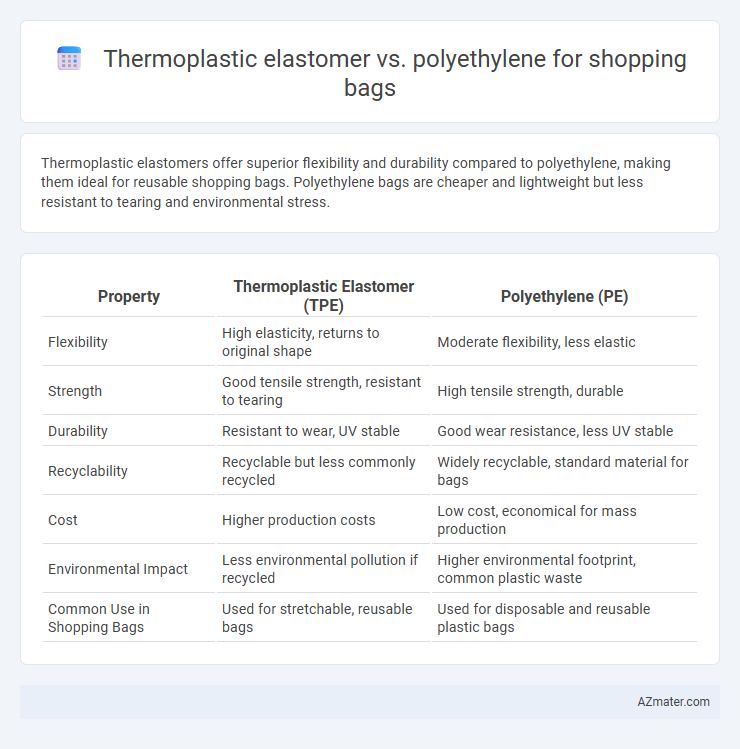Thermoplastic elastomers offer superior flexibility and durability compared to polyethylene, making them ideal for reusable shopping bags. Polyethylene bags are cheaper and lightweight but less resistant to tearing and environmental stress.
Table of Comparison
| Property | Thermoplastic Elastomer (TPE) | Polyethylene (PE) |
|---|---|---|
| Flexibility | High elasticity, returns to original shape | Moderate flexibility, less elastic |
| Strength | Good tensile strength, resistant to tearing | High tensile strength, durable |
| Durability | Resistant to wear, UV stable | Good wear resistance, less UV stable |
| Recyclability | Recyclable but less commonly recycled | Widely recyclable, standard material for bags |
| Cost | Higher production costs | Low cost, economical for mass production |
| Environmental Impact | Less environmental pollution if recycled | Higher environmental footprint, common plastic waste |
| Common Use in Shopping Bags | Used for stretchable, reusable bags | Used for disposable and reusable plastic bags |
Introduction to Shopping Bag Materials
Thermoplastic elastomers (TPE) and polyethylene (PE) are common materials used in manufacturing shopping bags, each offering distinct properties that influence bag performance. TPE combines the elasticity of rubbers with the recyclability of thermoplastics, providing flexibility, durability, and resistance to tearing. Polyethylene, widely used as low-density (LDPE) or high-density (HDPE), offers cost-effective production, moisture resistance, and moderate strength, making it a popular choice for disposable and reusable shopping bags.
Overview of Thermoplastic Elastomer (TPE)
Thermoplastic elastomer (TPE) is a versatile synthetic material combining the elasticity of rubber with the recyclability of thermoplastics, making it ideal for reusable shopping bags. TPE offers excellent durability, flexibility, and resistance to wear, which enhances the lifespan and usability of shopping bags compared to conventional polyethylene bags. Its environmental benefits include easier recycling processes and reduced plastic waste, supporting sustainable alternatives in retail packaging.
Overview of Polyethylene (PE)
Polyethylene (PE) is a widely used thermoplastic polymer ideal for shopping bags due to its excellent durability, flexibility, and moisture resistance. Its lightweight nature and cost-effectiveness make it a preferred material in the packaging industry, enabling efficient production and strong carry capacity. Polyethylene variants like LDPE and HDPE exhibit different strengths and flexibility, allowing customization based on shopping bag requirements.
Mechanical Properties Comparison
Thermoplastic elastomers (TPE) exhibit superior flexibility, elasticity, and impact resistance compared to polyethylene (PE), making them more resilient under mechanical stress for shopping bags. Polyethylene offers higher tensile strength and stiffness but lacks the elongation and recovery properties of TPE, often leading to brittleness under repeated use. The enhanced tear resistance and durability of TPE contribute to longer-lasting shopping bags that maintain integrity under heavy loads and dynamic handling.
Environmental Impact and Recyclability
Thermoplastic elastomers (TPE) offer enhanced flexibility and durability compared to polyethylene (PE), but PE remains more widely recycled due to established collection and processing systems, contributing to a lower environmental footprint in shopping bag applications. PE bags, especially high-density polyethylene (HDPE), are lighter and often accepted in municipal recycling programs, which facilitates effective recycling and reduces landfill waste. TPE bags, while potentially reusable, face challenges in recyclability because of mixed polymer compositions, leading to less efficient recycling processes and a higher environmental impact when not properly managed.
Cost Analysis and Economic Factors
Thermoplastic elastomers (TPE) typically incur higher material costs than polyethylene (PE) due to their complex manufacturing process and enhanced flexibility properties, impacting the overall expense of shopping bag production. However, TPE's durability and recyclability often contribute to long-term economic benefits by reducing replacement frequency and waste management costs. In contrast, polyethylene remains favored for cost-sensitive markets because of its low raw material price, widespread availability, and efficient mass production methods.
Durability and Usability for Shoppers
Thermoplastic elastomers (TPE) offer superior durability for shopping bags due to their high elasticity and resistance to wear, ensuring bags maintain integrity under repeated use and heavy loads. Polyethylene (PE), commonly used in disposable bags, provides decent flexibility but tends to tear more easily and degrades faster when exposed to UV light, reducing overall usability for shoppers. TPE bags often allow for better grip and stretch, enhancing shopper convenience by accommodating various item shapes and weights without compromising strength.
Customization and Design Flexibility
Thermoplastic elastomers (TPE) offer superior customization and design flexibility for shopping bags due to their ability to be easily molded into complex shapes and incorporate various colors and textures. Polyethylene (PE), while economical and durable, provides limited design options primarily restricted to simple forms and basic colors. TPE's elastic properties enable the creation of ergonomic handles and enhanced grip features that are difficult to achieve with polyethylene.
Market Trends and Consumer Preferences
Thermoplastic elastomer (TPE) shopping bags are gaining traction due to their flexibility, durability, and recyclability, aligning with rising consumer demand for sustainable and reusable alternatives to single-use polyethylene (PE) bags. Market trends indicate a shift towards eco-friendly materials, with TPE bags preferred for their enhanced elasticity and resistance to wear, appealing to environmentally conscious shoppers. Despite polyethylene's low cost and widespread use, regulatory pressures and increasing awareness of plastic waste are driving consumers and retailers to favor innovative TPE solutions in the shopping bag segment.
Conclusion: Choosing the Right Material for Shopping Bags
Thermoplastic elastomers (TPE) offer superior flexibility, durability, and recyclability compared to polyethylene (PE), making them a sustainable choice for reusable shopping bags. Polyethylene, particularly low-density polyethylene (LDPE), remains cost-effective and lightweight but often lacks the environmental advantages and elasticity found in TPE. Selecting TPE ensures enhanced performance and eco-friendliness, while polyethylene suits budget-conscious applications with less demand for durability.

Infographic: Thermoplastic elastomer vs Polyethylene for Shopping bag
 azmater.com
azmater.com